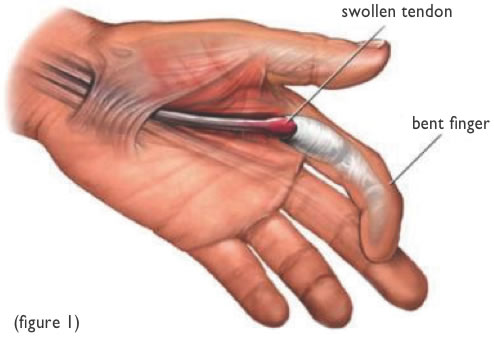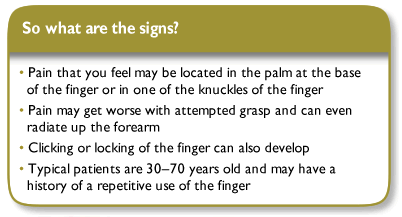|
Understanding Trigger FingerClint Merrick, MD Trigger finger (also called stenosing tenosynovitis) is one of the most common causes of hand pain and dysfunction. The basic cause of that pain is inflammation around the flexor tendons at the base of the finger (figure 1). This inflammatory condition results in swelling of the tendon and abnormal movement of the tendon through the tendon sheath. In addition to pain, this may cause a ‘popping’ of the finger as you try to make a fist or locking of the finger after making a fist. In some cases, the finger stays in the locked position and the patient may have to use their other hand to straighten it.
Early recognition that you may be developing trigger finger is the key to seeking the best remedy.
Treatment in the early phase may consist of stretching or splinting the finger. In some cases, this may help the condition and prevent the need for further intervention. If the pain or clicking continues, an injection of steroid and local anesthesia around the tendon may be required. This is an extremely effective treatment and is relatively painless because a local anesthetic is used. If the trigger finger recurs after the injection, another injection may be given with a maximum of three injections in any given finger recommended. If the condition persists, then surgery may be necessary.
This 15-minute procedure can be done with just local anesthesia or local anesthesia plus a mild sedative. Recovery is very quick as well. Most patients are using their finger again the night of surgery and full function can return in as little as two to three weeks. If you think you may have trigger finger, early diagnosis is the simplest and most effective way to avoid surgery. Early, non-surgical intervention may have a curative effect. If you think you may have this common condition, contact my office for a consultation. No referral is necessary.
Dr. Merrick – Merrick Plastic & Hand Surgery |





 Surgery is a definitive step required in some cases of trigger finger. Fortunately, it is a very minimal operation. The procedure consists of making a small, one centimeter incision in the palm at the base of the finger. A portion of the tendon sheath is opened and, when all is said and done, just two sutures are used to close the incision. Recurrence is extremely rare after surgery.
Surgery is a definitive step required in some cases of trigger finger. Fortunately, it is a very minimal operation. The procedure consists of making a small, one centimeter incision in the palm at the base of the finger. A portion of the tendon sheath is opened and, when all is said and done, just two sutures are used to close the incision. Recurrence is extremely rare after surgery.